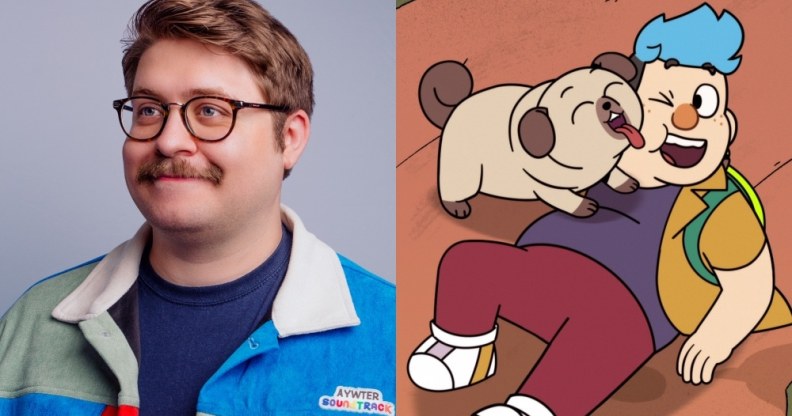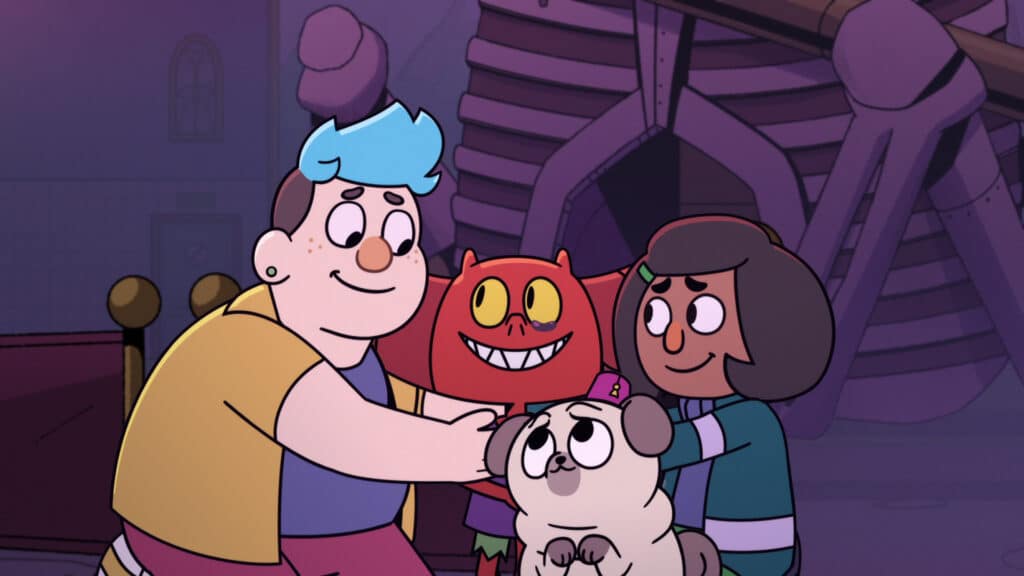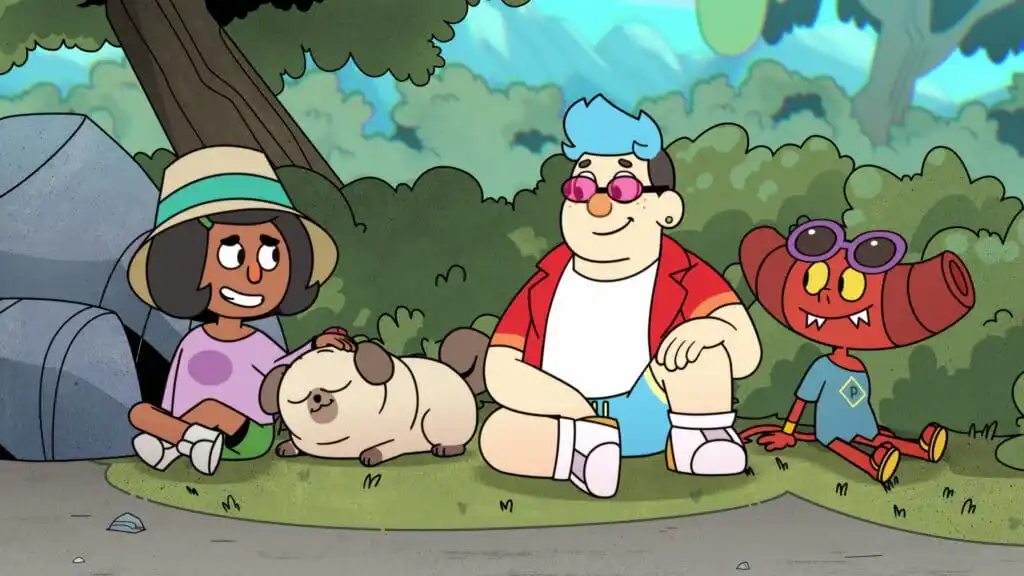Dead End: Paranormal Park creator on upsetting Republicans and the power of trans characters

Hamish Steele (L) is the creator behind the Netflix show Dead End: Paranormal Park. (Supplied/Netflix)
Hamish Steele (L) is the creator behind the Netflix show Dead End: Paranormal Park. (Supplied/Netflix)
Five Republican US senators last month sent an open letter to the TV Parental Guidelines Monitoring Board, demanding ratings are changed so parents are aware when children’s shows include “disturbing” LGBTQ+ content.
Dead End: Paranormal Park, a new series released on Netflix on 16 June, is on their hit list.
The letter bizarrely describes the push for LGBTQ+ inclusion as a “radical and sexual sensation”. Thankfully, Hamish Steele, the show’s creator, sees the humour behind the insanity.
“It was just so nuts that it’s funny,” he tells PinkNews. “Like, what porn are you watching? It sounds really boring!
“I was happy for the free publicity.”
Dead End: Paranormal Park is one of few TV animations aimed at young people that features a trans lead, Barney, voiced by trans actor Zack Barack.
The series follows Barney and friend Nora as they work in a theme park over summer, which turns out to be a “supernatural hive of chaos”, according to Hamish.
There’s comedy, horror, gay crushes, and thousand-year-old demons. Drag icon Miss Coco Peru voices a Dolly Parton-inspired theme park owner, while Pose actress MJ Rodriguez appears as a vampire queen. It’s pure, camp, queer magic.
What was once a webcomic and then a series of graphic novels, DeadEndia, is about to get a far larger audience as it lands on the streaming giant. With transphobes quick to attack any crumb of trans representation, is Hamish worried about backlash?

Dead End: Paranormal Park is one of only a few television shows to feature a trans-lead. (Netflix)
“It’s definitely something that I was a bit more aware of than some of the executives I was talking to at Netflix,” he says. While he’s had to develop a thick skin, he’s more focused on championing LGBTQ+ voices in the animation industry and ensuring the show reaches the right people.
“I can take a bit of the heat,” he says, “but I’m expecting there to be a lot more positivity than negativity.”
Hamish has received messages every day this week from fans who say seeing and reading about Barney has helped them to come out themselves. It’s a testament to the sheer power of seeing queer characters in the media, especially for young people, and particularly in the face of relentless attacks on the community.
“I understand that kids’ media can be escapism but it can also be a little beacon to tell people that you’re not alone, and other people are going through what you’re going through,” Hamish says.
The fact Barney is trans is only touched upon briefly in the series’ first episode when his mum naively mentions she hasn’t told his grandma about Barney’s identity, as “there’s a lot she doesn’t understand”.
Afterwards, Barney runs away to live at the theme park. It’s a subtle yet entirely intentional nod to the difficult conversations young queer people have to navigate regularly and the impact these conversations can have.
“We’re playing in quite nuanced areas. Barney’s parents aren’t horrifically abusive, they’re also not completely perfect,” Hamish says.
“We thought that parents might be watching with their children, so we wanted to make sure that there were lessons for the parents as well, about what actual unconditional love is.”
Hamish describes Dead End as “queer in its bones”, with LGBTQ+ representation and inclusion extending far beyond the characters themselves. Having a trans actor to voice Barney was a no-brainer, and he doesn’t think there are any excuses for not casting LGBTQ+ people in LGBTQ+ roles.

(L to R) Kody Kavitha as Norma, Alex Brightman as Pugsley, Zach Barack as Barney and Emily Osment as Courtney. (Netflix)
“Any debate has nuance,” he says, “[but] if you’re not casting trans people as trans characters, who are you casting them as?
“It’s definitely about finding the best actor for the job but the best actor for the job is 99 per cent often the person with the life experience to draw from.”
For Hamish though, LGBTQ+ representation on screen is only one piece of the puzzle, particularly in a field like animation, where every series requires designers, writers, storyboard creators and more.
“Representation on screen is very important but I think representation off-screen is the priority,” he says. “I feel like our stories shouldn’t really be told unless we’re getting paid.”
Despite recent controversies surrounding Netflix and its approach to LGBTQ+ lives — from cutting LGBTQ+ jobs to giving Ricky Gervais a platform to air his transphobia — Hamish’s experience of producing Dead End has been positive.
When he pushed for more LGBTQ+ characters and trans guest stars, he got them without pushback. It was a refreshing experience for the creator, who, 10 years into his career, has dealt with a fair share of casual homophobia in the industry.
“Now, there’s a lot of celebration of the queer characters, but [it used to be] the understood order that you cannot put [queer] characters in cartoons as that’s inappropriate,” he says.
“As a gay person working in the industry, it’s hard to hear that and not think that you are inappropriate.”
A series like Dead End is hopefully a sign things are moving forward. Heartstopper, for example, is proof LGBTQ+ content can be both successful and life-changing, while even Disney has caught on, promising a wave of new queer characters in the future.
While the outside world continues to be a gruelling place for the community, particularly for trans youth, perhaps this potential sea change can offer some much-needed respite.
For Hamish, he hopes the show sends a clear message of support to young trans people.
“I think what I would actually want is the show to be a radio signal to a lot of kids that, actually, a lot of grown-ups are on your side,” he says.
“It’s not as doom and gloom as it might seem.”

